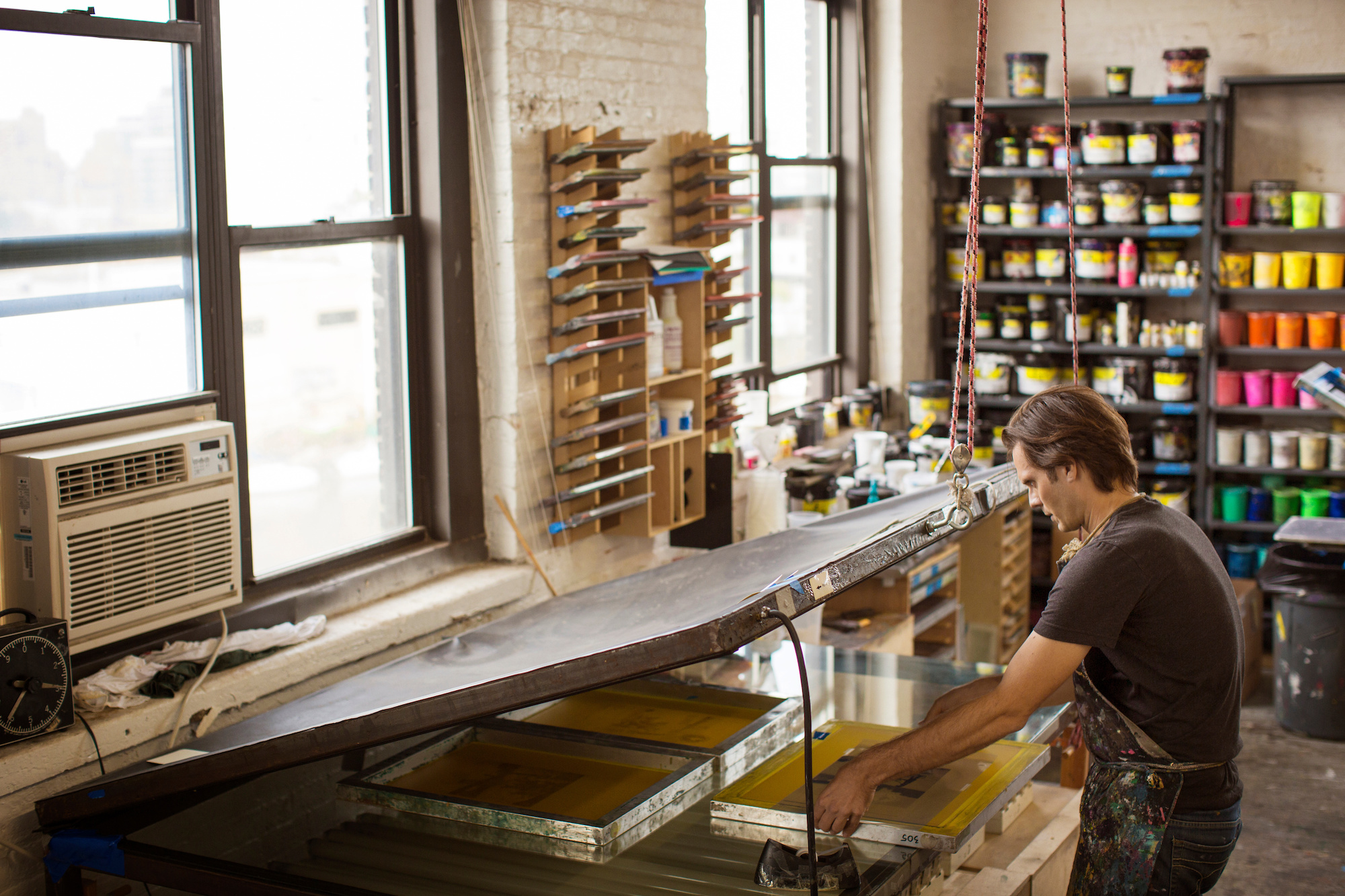Screen printing is far more than just frames, inks and presses. Here we’ve provided a list of accessories that we feel are useful for ensuring your screen printing workshop achieves the best possible results.
- In this article:
- The absolute “must-haves” for a screenprinting workshop: scrapers
- Removable adhesive tape: never be without it!
- Water-based glue for printing stations
- Sprayers (for water or glue)
- Empty jars for mixing inks
- Solvent and sponges for cleaning screen printing screens
- Rolls of paper hand towels
- Disposable gloves
In a screen printing workshop, you would expect to find a screen printing frame, a squeegee, different ink types – water-based, plastisol, solvent-based – depending on the type of printing.
However, a good workshop is incomplete and somewhat unprofessional if it lacks certain useful accessories that make working easier and help achieve the best possible printing results.
Here’s a list of accessories you might find useful in your screen printing workshop.
The absolute “must-haves” for a screenprinting workshop: scrapers
For getting the ink from the jar and spreading it on the screenprinting screen, at least two different types of scraper should be on hand in the workshop.
Flat scraper and angled scraper
The two scrapers differ in the shape of their stainless steel blade, and can be used depending on which is more useful for the job in hand. For example, when removing excess ink from the screen and putting it back in the jar, the angled scraper is usually the better option.
A very important aspect of the scraper is the shape of its end: it must always be rounded, so as to ensure it doesn’t damage the screen’s mesh.
As for what it’s made of, we recommend a stainless steel blade, so that it doesn’t rust, with either a plastic (slightly more expensive) or wooden handle (cheaper).
Removable adhesive tape: never be without it!
Adhesive tapes used for screen printing should always be easy to remove and should never leave any adhesive behind.
In screenprinting, adhesive tape is used in four different cases:
– to protect the frame and prevent ink from going through the mesh in the space between the frame and the emulsion
– to prevent the inside of the frame from becoming soiled with ink or absorbing it and quickly becoming damaged, especially if it’s made of wood.
– it can be used on the printing side to hide any designs that have been placed on the same screen and that, in this session, we don’t wish to print
– to prevent solvent, used for cleaning the frame, from getting between the mesh and the frame, thus damaging the glue and causing the mesh to detach from the frame.
Water-based glue for printing stations
This section answers one of the questions that we’re most often asked via our blog: how do you hold the T-shirt, or sheet of paper, steady during printing? How to make sure the T-shirt doesn’t move when you lift the screen, so that you get a perfect print?
There’s a very simple approach: apply some removable glue to the printing station.
Water-based screenprinting glue temporarily sticks cotton or paper to the printing station, and when you lift the screen it stops the T-shirt or sheet from moving, even just a few millimetres.
Sprayers (for water or glue)
Plastic bottles with a spray nozzle are useful for spraying glue – diluted in water according to instructions – onto the printing station. We suggest having two types of sprayers available in the workshop: one filled with glue, the other filled with just water.
Water can be sprayed onto ink to make sure it stays damp and to prevent it from drying on the screen.
Tip -> Always put a label on the sprayer that contains just water, so you don’t mix them up.
Empty jars for mixing inks
Screenprinting ink should never be wasted, because of the cost, but also to respect the environment.
For this reason, we suggest always having some empty jars handy, so that you can pour, mix and dilute the ink you need for printing. Half-kilo jars are ideal.
Any unused ink can be kept, with the lid tightly closed, in the original container.
Solvent and sponges for cleaning screen printing screens
When you’ve finished printing, you need to remove all traces of ink from the screen as soon as possible, every tiny bit of remaining residue, so as to prevent it from going solid on your equipment and quickly damaging it.
This is what screen cleaning solvent is for. This product is only needed for plastisol screen printing inks. Water-based inks can simply be cleaned off with water. There are some virtually odourless solvents on the market today; we recommend using them when printing in a small environment.
Rolls of paper hand towels
Having some rolls of paper hand towels available in the workshop is an absolute must during every phase of the screen printing process.
They can be used for cleaning ink off scrapers, cleaning frames, keeping the printing station clean, etc. You should always have a roll on hand.
Disposable gloves
These are essential in the workshop for protecting your hands, for making sure they don’t get too dirty when using inks, and for avoiding direct contact with solvents and thinners. We recommend very thin gloves, so as not to lose the sense of touch while working.
To conclude
- We recommend that you always have a number of indispensable tools and accessories available in your workshop:
- Two scrapers
- Removable adhesive tape
- Water-based glue
- Sprayers
- Empty jars
- Solvent and cleaning materials
- Rolls of paper hand towel and disposable gloves
Visit our shop
where you can find all these “must-haves” for your day-to-day screenprinting activities.

